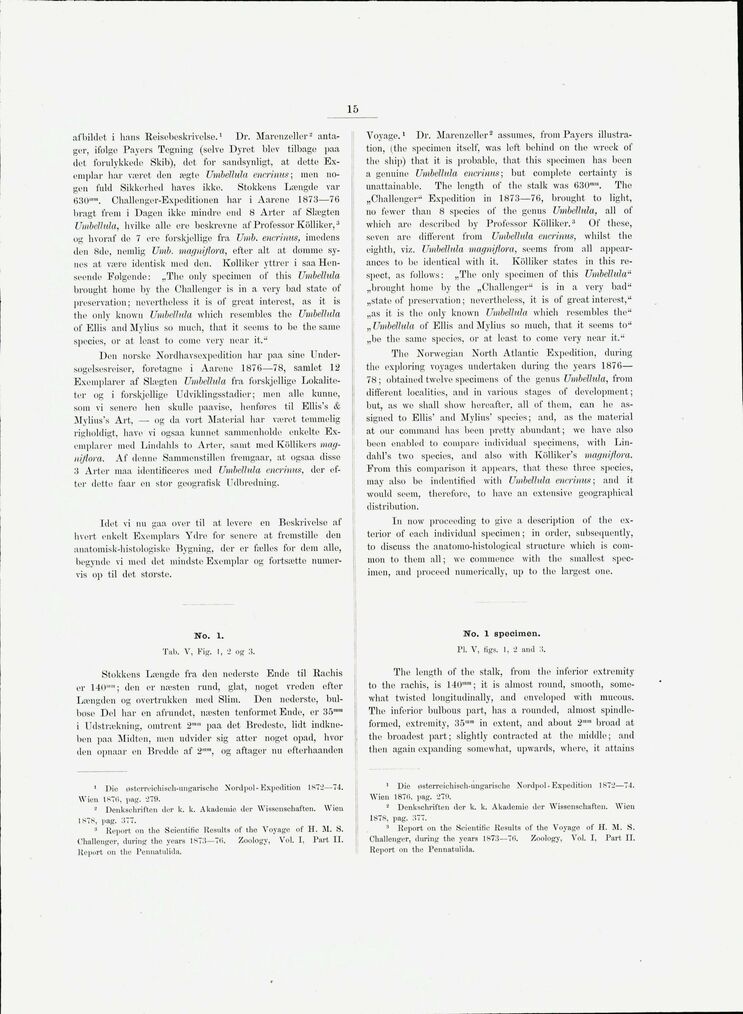
Full resolution (JPEG) - On this page / på denna sida - Sidor ...

<< prev. page << föreg. sida << >> nästa sida >> next page >>
Below is the raw OCR text
from the above scanned image.
Do you see an error? Proofread the page now!
Här nedan syns maskintolkade texten från faksimilbilden ovan.
Ser du något fel? Korrekturläs sidan nu!
This page has never been proofread. / Denna sida har aldrig korrekturlästs.
15
afbildet i hans Reisebeskrivelse.1 Dr. Marenzeller2
antager, ifølge Payers Tegning (selve Dyret blev tilbage paa
det forulykkede Skib), det for sandsynligt, at dette
Exemplar har været den ægte Umbéllula encrinus; men
nogen fuld Sikkerhed haves ikke. Stokkens Længde var
630""". Challenger-Expeditionen har i Aarene 1873—76
bragt frem i Dagen ikke mindre end 8 Arter af Slægten
Umbéllula, hvilke alle ere beskrevne af Professor Kölliker,3
og hvoraf de 7 ere forskjellige fra Umb. encrinus, imedens
den 8de, nemlig Unib. mag ni fl ora, efter alt at domme
synes at være identisk med den. Kölliker yttrer i saa
Henseende Følgende: „The only specimen of this Umbelhila
brought home by the Challenger is in a very bad state of
preservation; nevertheless it is of great interest, as it is
the only known Umbelhila which resembles the Umbéllula
of Ellis and Mylius so much, that it seems to be the same
species, or at least to come very near it."
Den norske Nordhavsexpeclition liar paa sine
Under-sögelsesreiser, foretagne i Aarene 1876—78, samlet 12
Exemplarer af Slægten Umbéllula fra forskjellige
Lokaliteter og i forskjellige Udviklingsstadier; men alle kunne,
som vi senere hen skulle paavise, henføres til Ellis’s &
Mylius’.s Art, — og da vort Material har været temmelig
righoldigt, have vi ogsaa kunnet sammenholde enkelte
Exemplarer med Lindahls to Arter, samt med Köllikers
mag-niflora. Af denne Sammenstillen fremgaar, at ogsaa disse
3 Arter maa identificeres med Umbéllula encrinus, der
efter dette faar en stor geografisk Udbredning.
Idet vi nu gaa over til at levere en Beskrivelse af
hvert enkelt Exemplars Ydre for senere at fremstille den
anatomisk-histplpgiske Bygning, der er fælles for dem alle,
begynde vi med det mindste Exemplar og fortsætte
liumer-vis op til det største.
Voyage.1 Dr. Marenzeller2 assumes, from Payers
illustration, (the specimen itself, was left behind on the wreck of
the ship) that it is probable, that this specimen has been
a genuine Umbelhila encrinus; but complete certainty is
unattainable. The length of the stalk was 630mm. The
„Challenger" Expedition in 1873—76, brought to light,
no fewer than 8 species of the genus Umbéllula, all of
which are described by Professor Kölliker.8 Of these,
seven are different from Umbéllula encrinus, whilst the
eighth, viz. Umbéllula magni flor a, seems from all
appearances to be identical with it. Kölliker states in this
respect, as follows: „The only specimen of this Umbellulail
„brought home by the „Challenger" is in a very bad"
„state of preservation; nevertheless, it is of great interest,"
„as it is the only known Umbéllula which resembles the"
„ Umbéllula of Ellis and Mylius so much, that it seems to"
„be the same species, or at least to come very near it."
The Norwegian North Atlantic Expedition, during
the exploring voyages undertaken during the years 1876—
78; obtained twelve specimens of the genus Umbelhila, from
different localities, and in various stages of development;
but, as we shall show hereafter, all of them, can he
assigned to Ellis’ and Mylius’ species; and, as the material
at our command has been pretty abundant; we have also
been enabled to compare individual specimens, with
Lin-dahl’s two species, and also with Kölliker’s magnißora.
From this comparison it appears, that these three species,
may also be indentified with Umbelhila encrinus; and it
would seem, therefore, to have an extensive geographical
distribution.
In now proceeding to give a description of the
exterior of each individual specimen; in order, subsequently,
to discuss the anatomo-histological structure which is
common to them all; we commence with the smallest
specimen, and proceed numerically, up to the largest one.
No. 1.
Tab. V, Fig. 1, 2 og 3.
Stokkens Længde fra den nederste Ende til Rachis
er 140"""; den er næsten rund, glat, noget vreden efter
Lamgden og overtrukken med Slim. Den nederste,
bulbøse Del har en afrundet, næsten tenformet Ende, er 35"""
i Udstrækning, omtrent 2""" paa det Bredeste, lidt
indkneben paa Midten, men udvider sig atter noget opad, hvor
den opnaar en Bredde af 2mm, og aftager nu efterhaanden
No. 1 specimen.
Fl. V, ligs. 1, 2 and 3.
The length of the stalk, from the inferior extremity
to the rachis, is 140"""; it is almost round, smooth,
somewhat twisted longitudinally, and enveloped with mucous.
The inferior bulbous part, has a rounded, almost
spindle-formed, extremity, 35""" in extent, and about 2’"’" broad at
the broadest part; slightly contracted at the middle; and
then again expanding somewhat, upwards, where, it attains
1 Die østerreichisch-ungarische Nordpol-Expedition 1872—74.
Wien 187(i, pag. 279.
Denksehriften dor k. k. Akademie der Wissenschaften. Wien
1878, pag. :S77.
3 Report on the Scientific Results of the Voyage of H. M. S.
Challenger, during the years 1S73—7(>. Zoology, Vol. I, Part II.
Report on the Pennatulida.
1 Die østerreichisch-ungarische Nordpol-Expedition 1872—74.
Wien 187(1. pag. 27!).
2 Denksehriften der k. k. Akademie der Wissenschaften. Wien
1878, pag. 377.
3 Report on the Scientific Results of the Voyage of H. M. S.
Challenger, during the years 1873—7<>. Zoology, Vol. I, Part II.
Report on the Penuatulida.
<< prev. page << föreg. sida << >> nästa sida >> next page >>